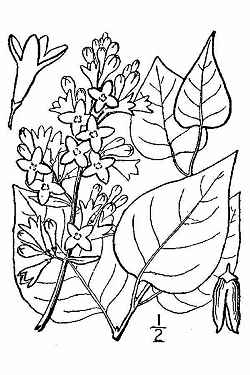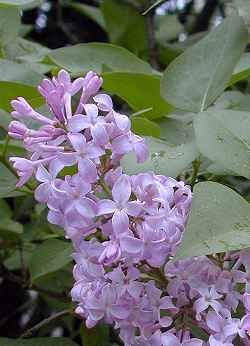
Syringa vulgaris, Britton, N.L., and A. Brown. 1913. Illustrated flora of the northern states and Canada. Vol. 2: 724. Courtesy of Kentucky Native Plant Society.
Sunset®: 1-11 blooms irregularly in 12-16,18-22
USDA: 3b-9b
Sun Exposure: Full sun
Origin: Europe and North Africa
Growth Habits: Deciduous shrub, up to 15 feet tall (4.5 m); simple, dark green, opposite, heart shaped leaves 2 to 4 inches long (5-10 cm), 1.6 to 3 inches wide (4-7.5 cm)
Flowers: White, pink, red, purple, violet or blue flowers
Watering Needs: Regular water in the spring, slightly alkaline soil
Propagation: Cuttings, seeds
Propagation: Seed or occasionally cutting, layering, grafting/budding
- by softwood, hardwood stem tip, root cuttings, in spring. Apply IBA TALC 8000 PPM. Use intermittent mist. Root in 4-8 weeks. Cuttings with mature leaves (vegetative shoots) are preffered rather than shoots with flower buds..
- by trench layers, in late autumn.
- by whip, 'T' grafts, in late summer. Use a S. villosa or ligustrum ovalifolium or green ash as graftstock. Grafting done in Jan. indoors and plants stored in cool storage room until spring planting. Grafting is not a good way to propagate lilacs because of its suckering habits. The understock may take over the graft.
- by seeds, in spring. The seeds can be harvested in early autumn. The seeds need stratify 40F 2-3mo..

Blooming Habits:
Showy, fragrant, light purple, pink or even white flowers, in mid-spring, in large terminal clusters, 4 to 8 inches long (10-20 cm). Without enough winter chilling, lilac don't bloom properly. Some hybrids like "descanso" need much less chilling.
Culture:
The lilacs bloom on the previous year wood. Pruning should be done after the blooming is finished. They transplant easily.
Desert-Tropicals is dedicated to provide gardening advice, gardening ideas, and information about flower of all kind for landscape and collections.We try to check carefully the identification of the plants on the illustrations as well as the other information from the page, but occasionally errors do occur. if you notice anything that needs to be changed please contact us.Thanks.
© 1998-2020 Philippe Faucon, All Rights Reserved.